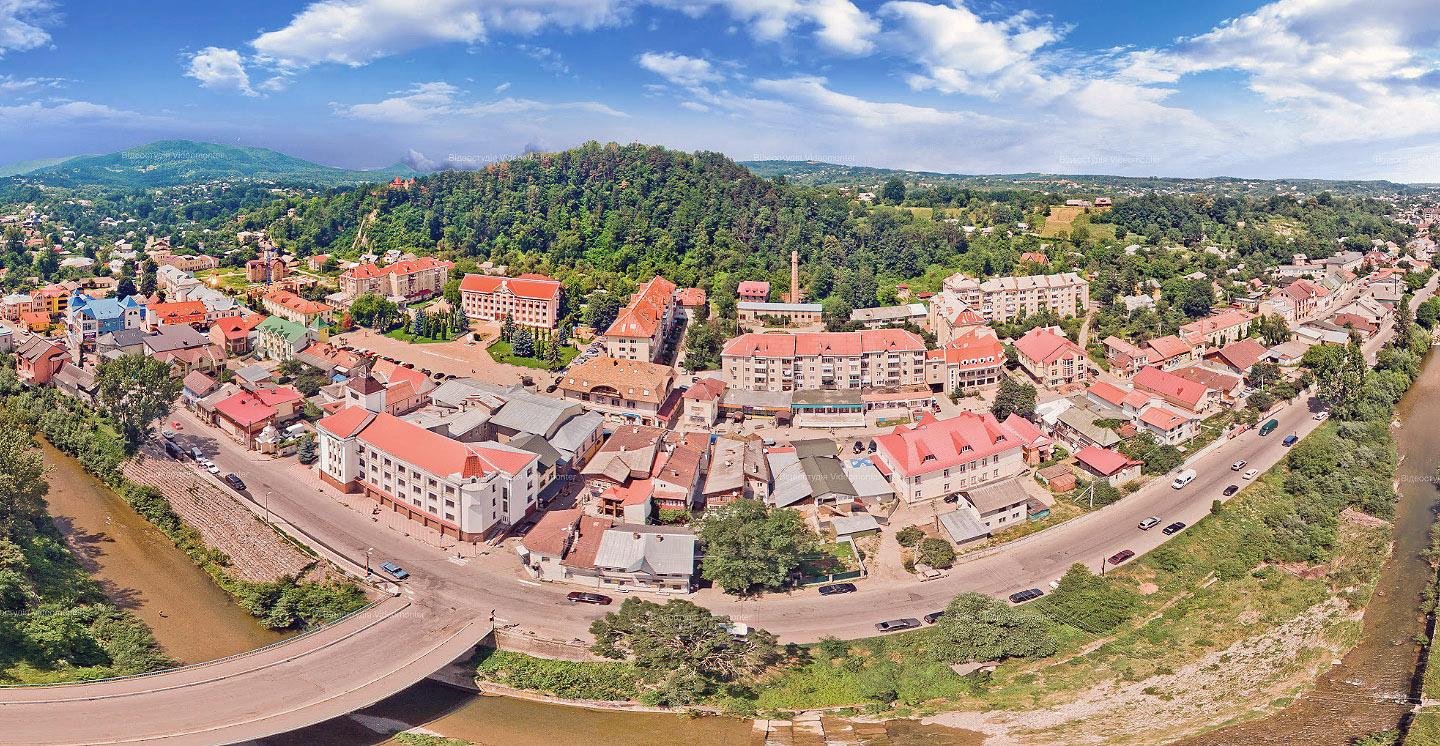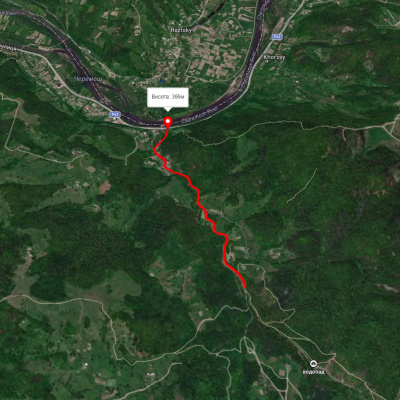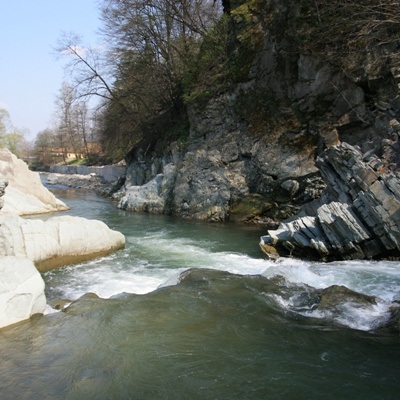Kosiv is a city in Ukraine, the district center of Kosiv district in Ivano-Frankivsk region, the administrative center of Kosiv district council, and the administrative and commercial center of the Galician Hutsul region. It is located at the foot of the Ukrainian Carpathians (Pokutsko-Bukovynski), in the valley of the Rybnitsa River, a tributary of the Prut. The height above sea level is 300-450 m. Distance to: Ivano-Frankivsk - 92 km, Kolomyia - 35 km, Verkhovyna - 33 km, Chernivtsi - 78 km, Yaremche - 76 km. Motorway connection: Ivano-Frankivsk - Kolomyia - Kosiv, Yaremche - Kolomyia - Kosiv, Chernivtsi - Sniatyn - Kosiv, Kamianets-Podilskyi - Kosiv. The nearest railway stations are Vyzhnytsia station - 12 km and Kolomyia station - 37 km. The nearest airport is in Ivano-Frankivsk - 93 km. Peaks near Kosiv: Mount Zinyakov Verkh - 710 m, Mount Kamenistyi - 632 m, Mount Ostryi - 584 m, Mount Holytsia - 691 m, Mount Mykhalkiv - 812 m, Mount Baranivka - 561 m, Mount Khomynskyi - 816 m.
According to the Resolution of the Cabinet of Ministers of July 16, 2001, No. 878 "On Approval of the List of Historical Settlements of Ukraine", Kosiv was granted the status of a historical city. In September 2004, the city of Kosiv was granted a new status - Kosiv resort town. Kosiv is the largest center of applied arts in the Carpathians. According to one legend, the name comes from the word "kos" (the Hutsul name for a blackbird), which was very abundant in the forests surrounding Kosiv. According to another legend, Prince Danylo Halytskyi sent his boyar Kosych to the mountains with orders to strengthen the borders of the Galician land. Kosych settled in a wild mountainous region and the settlement was named after him.

The earliest historical mention of Kosiv dates back to 1424: Grand Duke Svydryhailo of Lithuania granted the village to his "faithful servant" Maksym Dragosynovych. The settlement became a city in the second half of the 16th century during the Polish-Lithuanian era due to its valuable salt deposits. By that time, a quarter-mile from the village of Kosiv (now Staryi Kosiv), there was a salt bath where salt was boiled from the extracted raw materials. Both the village and the bathhouse were royal (state) property, and therefore administratively part of the Sniatyn starosta and subordinate to the starosta, a representative of the king. Sniatyn starostas, using their right, rented the Kosiv bathhouse and received income from it, and around 1560 the then starosta Genchynskyi founded the town of Rykiv near it. After his death, the subjects and servants of Yurii Yazlovetskyi, who had received the village of Kosiv as a land lease, armed themselves and destroyed Rykiv, and Yazlovetskyi seized the salt bath.
After some time, the town was restored under its modern name: the tax register of 1579, along with the name "Koszow, villa" (Kosiv, village), records "Koszow, oppidum" (Kosiv, town). In the same document, Kosiv appears as a private town owned by Michał, the son of Jerzy (Yurii) Jazłowiecki. Once in the hands of the gentry, Kosiv separated from the Sniatyn starosta and formed a separate Kosiv parish together with four villages in the possession of Michał Jazlowiecki. Until the collapse of the Polish Kingdom, Kosiv remained private and was inherited from one owner to another. Twice the town was burned and destroyed: in the fall of 1621 by Turks, Tatars, and Vlachs (subjects of the Ottoman Empire), and in February 1624 by the Budzhak Tatars.
Salt mining and production required the employment of many workers and artisans. The excellent climate attracted settlers, and horticulture developed well. Taking care of increasing their profits, the owners of Kosiv encouraged Jews to settle here with various privileges, and they successfully engaged in trade, renting estates and industrial establishments (saltworks, mills, taverns, etc.), collecting taxes, etc. The central part (the city center) was dominated by the Jewish population, while the outskirts, which were originally separate villages (Monastyrske and Moskalivka), were inhabited mainly by Ukrainians. In Kosiv and its environs, there were about 50 percent Ukrainians, 35 percent Jews, and 15 percent Poles. Many of them were getting rich quickly. This attracted the attention of the opryshky. They frequently attacked the town, in particular under the leadership of Vasyl Lunga (1698), Pinti and Pisklyvy (1704), and Bayurak (1750). Around 1740, Oleksa Dovbush approached the noble court in Kosiv and for some reason "sent guns to the court" but did not attack. After Dovbush's execution, according to legend, the Polish authorities placed one of his body pieces on the City Hill to intimidate the opryshky. In 1759, in connection with the intensification of the opryshko movement, the main camp of the punitive army against the opryshkos was organized, led by Tadeusz Diduszycki, the then owner of Kosiv and a Galician chorunzhy.
In Austrian times, life became more orderly. According to patents of 1773, 1778, and 1786, aimed at obtaining salt, the Kosiv salt estates, i.e. the town with the surrounding villages, passed from private to state ownership. Administratively, for several years it belonged to the Chervonorus district ("circular"), then to the Stanislaviv district, and finally to the Kolomyia district. With the introduction of the new system of government in 1867, Kosiv was granted the status of a county town, which transferred all administrative and political power to the county administration, a starosta headed by a starosta and directly subordinated to the Galician governorate in Lviv. In addition to salt production, artistic crafts such as carving, embroidery, carpet weaving, and ceramics were developed. In 1850, a weaving society was founded, and Kosiv became a center of weaving. In 1882, the weaving society founded a weaving school. At the end of the XIX century, a very promising resort industry began to develop.
Kosiv is famous for its patterned fabrics - artistic handwoven products used for home decoration and clothing. In the 2nd half of the 20th century, patterned spindles with transverse stripes, bedspreads, polychrome belts with rich patterns, etc. were a common type of artistic fabrics. Kosovo patterned fabrics have been widely developed since the 40s of the twentieth century. During this period, a number of weaving artels were created in Kosiv and the surrounding villages, which were later consolidated and reorganized into factories. Today, the largest number of artistic textile products are produced in Kosiv by Hutsulshchyna and the Art and Production Plant. Artistic fabrics (carpets, spindles, bedspreads, chair covers, towels, tablecloths, sewing, clothing fabrics, etc.) are made mainly of woolen yarn. The technique of making Kosiv patterned fabrics is mostly shuttle weaving, but carpet weaving is also common, as well as hand-weaving and plank weaving. The most characteristic of Kosiv fabrics are cross-striped patterns made in bright, golden-yellow colors, complemented by blue, green, purple, and white.
As part of the Ukrainian national revival that took place throughout Galicia, the Ukrainian Radical Party had a significant influence in Kosovo at the turn of the nineteenth and twentieth centuries. One of its founders, along with Ivan Franko and other figures, was Mykhailo Pavlyk from Kosiv. The Sich, Volia, Women's Community, and Prosvita societies were active. On July 19, 1914, a monument to Taras Shevchenko was erected. In June 1914, the first unit of the Sich Riflemen was created. At the beginning of the First World War, the district administration of the USS recruited volunteers to fight on the side of Austria. From fall 1914 to early summer 1915 and from summer 1916 to summer 1917, Kosiv was captured twice by the Russian army, which committed terrible pogroms and looting during the retreat. After the collapse of Austria-Hungary (November 1918), the Western Ukrainian People's Republic was established, which lasted until May 1919. From May 26 to the end of August, the city was captured by Romanian troops. Subsequently, along with many other lands of Western Ukraine, it became part of Poland, and the Kosiv district was included in the Stanisławów Voivodeship.
Under Polish rule, artistic crafts continued to develop, in particular, the carpet weaving companies Hutsulske Arty, Hrinkowski, Medvedchuk, and Gilman, and the knitting companies Schnieberg and Rund. The influx of summer residents and vacationers increased especially, with an annual attendance of about 3,000 people, and a wide network of boarding houses provided services to them. The heyday of the salt industry was slowed down, and in 1938 the saltworks were finally shut down.

On April 1, 1929, by order of the Council of Ministers, the city of Kosiv was significantly expanded by annexing parts of the villages of Staryi Kosiv and Verbovets, and on March 26, 1934, the city's territory was expanded by annexing the village of Moskalivka.
On September 22, 1939, Soviet rule was established in Kosiv. Under the slogan of helping the oppressed "Ukrainian brothers," boarding houses, carpet mills, mills, shops, and other businesses controlled mainly by Poles and Jews were nationalized. A secondary school with Ukrainian as the language of instruction was opened. A multidisciplinary industrial school of Hutsul art was established on the basis of a weaving factory. At the same time, the Soviet authorities liquidated Ukrainian political parties, organizations, and cooperatives, and on the night of December 19, 1940, 18 men were arrested and killed in search of imaginary "enemies of the people."
At the beginning of the German-Soviet war, on July 1, Kosiv was temporarily captured by Hungarian troops allied with Germany, who looted shops, boarding houses, and homes, taking dishes, linens, tables, chairs, drawings, windows, and doors, and transporting all of this to Hungary, but did not prevent the formation of a Ukrainian administration. The Germans, who took over from the Hungarians in August, launched a series of terrorist actions: in the first days they immediately arrested and shot OUN members who had come out of hiding under the Hungarians. On October 16-17, 1941, early in the morning, the Germans suddenly surrounded the Jewish neighborhoods, drove everyone out into the streets, and escorted them in columns to the prison, and from there they drove them up Pistynska Street to the mountain, and then took them to large pits dug on the City Hill. They were forced to take off their clothes, and then brought to the edge of the pit and killed by shooting them in the head. There was no mercy for women, old people, or babies. The rest were taken to the ghetto (Kolomyia) and later shot in the Sheparivskyi forest. Hundreds of people were taken to work in Germany; an artificial famine was created.
To protect the population from the arbitrariness of the German authorities, in June 1943 the OUN leadership organized the Ukrainian People's Self-Defense (UNS) in the Carpathian forests, which was incorporated into the UPA on January 27, 1944.
On March 31, 1944, Kosiv was captured by the Red Army, and the mountainous terrain outside the city was taken by the Hungarians. Until the summer, the city remained on the front line, and as a result, it suffered significant damage. After the failure of the long-lasting liberation struggle of the UPA and the SB (secret police of the OUN), the Bolshevik government took over for the second time, cracking down on the subjugated people by organizing executions and deportations of "unreliable elements." In the postwar period, it slowed down the development of resort tourism, instead giving priority to folk artistic crafts, such as the Hutsulshchyna carving artel and the Taras Shevchenko and Ivan Franko carpet factories, on the basis of which the Hutsulshchyna production and artistic associations and the artistic and production workshops of the Union of Artists began operating in 1968.
In 1969, one of the first rock bands in Ukraine, Hutsuly, was founded in Kosovo. After Ukraine regained its independence , Kosovo's efforts were aimed at reviving its culture, spiritual life, and economy. Various public organizations, political parties, church communities, and the city government, which has obtained a special charter for the resort town, are working in this direction.
Kosiv has a great potential to become the cultural center of the Hutsul region. There are all the prerequisites for this: artists who pass on their skills from generation to generation, recognized art schools, poeticism of Kosiv residents, and its location in the heart of the Hutsul region. The land of legends and tales, the places of glory of the opryshky, and the picturesque nature outline the Kosiv region's strategy for developing the tourism business. In 2004, Kosiv was among the top eight cities in Ukraine in terms of the number of green spaces per capita (65.2 m² per capita, while the international norm is at least 20 m²).
On the city's Day, the Ludynie festival is held (July 7), a festival of authentic and modern clothing with folklore elements.
The Hutsulshchyna National Nature Park was established on May 14, 2002. The length of the Park from northwest to southeast is about 29 km, and from northeast to southwest - 20 km. Tourist routes: 6 nearest mountain hiking routes: 1. City Mountain 2. Mikhalkova 3. Golitsa ridge 4. Sopka (Zinyakov Verkh, Stizhky) 5. Rocky ridge 6. Ostry ridge.
The rope tow lift on Mikhalkova Mountain (812 m above sea level, the highest in Kosovo) was founded in 1975. The length of the lift is 900 m, and the ski run is 1200 m. The height difference is 250 m. The number of trails is 5. The downhill run is 1200 m long. Giant slalom - 1000 m. Special slalom - 500 m.
Museums and attractions
- Kosiv Museum of Folk Art and Life of the Hutsul Region;
- Museum of folk art from the collection of Mikhail Strutynsky;
- Museum of the Kosiv State Institute of Applied and Decorative Arts;
- Museum of the Liberation Movement of the Carpathian Region;
- Private museum-estate of Hutsul art of the Korneliuk family;
- Private Museum of the Strynadiuk family "Koka";
- Taras Strynadiuk Museum of Sacred Art;
- Vasyl Strypko's family museum of ceramics;
- Hennadii Maliavskyi's home museum;
- Home Museum of Ivan Pavlyk;
- House Museum of Women's Jewelry;
- Creative workshop of Ivanna Kozak-Dileti;
- Kosiv Bazaar (open twice a week on Thursday and Saturday from 6.00 to 10.00) - the largest fair of Hutsul folk art in Prykarpattia;
- City (Castle) Mountain (450 meters above sea level) - a panoramic view of Kosiv and the surrounding areas, Pokutsko-Bukovyna Carpathians.
Які туристичні (пішохідні) маршрути проходять через/біля Kosiv?
Пропонуємо пройти такі туристичні (пішохідні) маршрути через/біля Kosiv: пер. Німчич - Протяте Каміння, Смугарські водоспади, Шешори - Росохата, с. Буковець – Писаний Камінь – с. Буковець, Писаний Камінь – с. Буковець, с. Космач, через г. Ротило, г. Грегіт, г. Біла Кобила до с.Буковець








